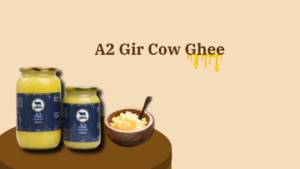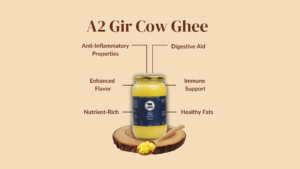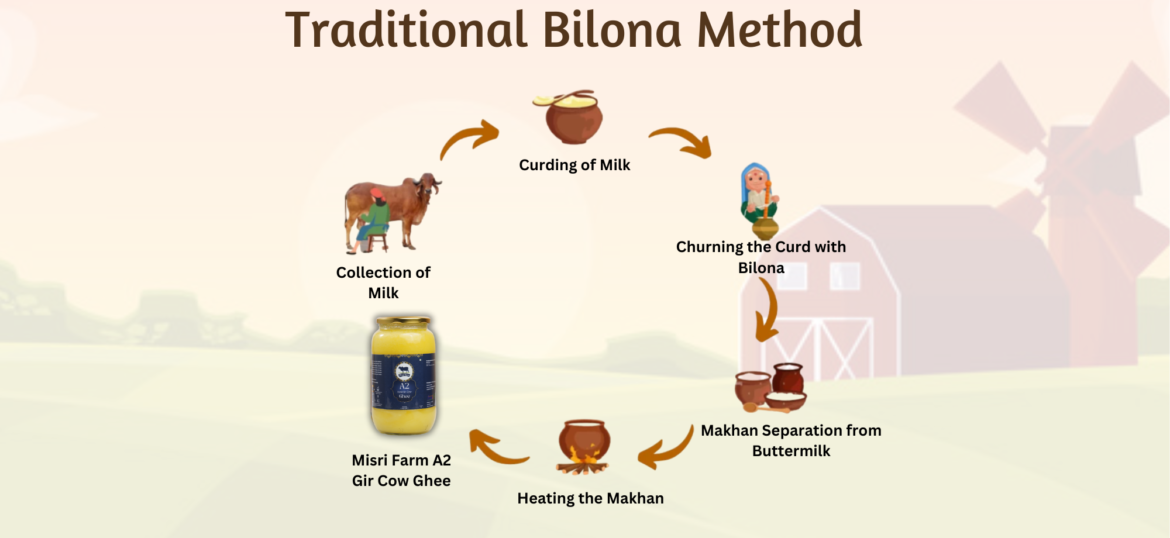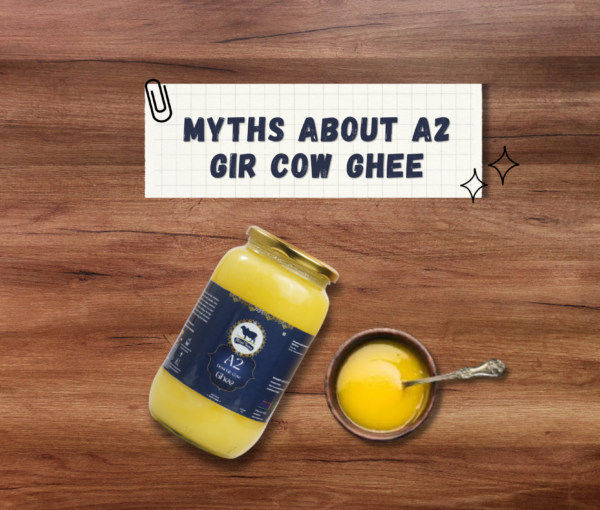In recent years, there has been a growing interest in traditional and natural foods, and A2 Desi Gir Cow Ghee has become a standout favorite among health enthusiasts. One of the best-known varieties is A2 Gir Cow Ghee, which is renowned for its purity and nutritional benefits. This blog will take you through the ghee-making process of using the traditional Bilona method, highlighting Ghee benefits and why it stands out in the market.
What is A2 Gir Cow Ghee?
A2 Gir Cow Ghee is derived from the milk of Gir cows, an indigenous breed native to India. The A2 protein found in this ghee is different from the A1 protein present in most commercial dairy products. Many people find A2 ghee easier to digest and believe it offers superior health benefits.

The Process of Bilona Method
The Bilona method is an age-old technique used to make ghee, ensuring that it is not only delicious but also rich in nutrients. Here is a step-by-step overview of how A2 Gir Cow Ghee is made using this traditional method:
Step 1: Milking the Cows
The process begins with Gir cows, known for producing high-quality milk. These cows are typically fed grass and live in a natural setting. This healthy, natural lifestyle helps them produce top-quality milk. The milking process involves gently extracting the milk from the cows, ensuring they are comfortable and stress-free. The care given to the cows and their natural diet contributes to the rich, nutritious milk they provide, making it an essential part of dairy farming.
Step 2: Curd Preparation
To prepare curd, start with fresh milk, which is first boiled and then cooled to a lukewarm temperature. Once the milk is lukewarm, add a small amount of existing curd (yogurt), which acts as a starter. This mixture is then left to sit undisturbed overnight. During this time, the milk ferments and thickens, turning into curd. The process relies on the natural bacteria in the starter curd to convert the milk into a thick, creamy curd by morning.
Step 3: Churning the Curd
The curd is churned using a wooden churner, also known as a ‘Bilona’. This can be done manually or using a traditional wooden device called a ‘mathani’. The churning process separates the butter from the buttermilk. This step is crucial as it is done slowly to ensure the maximum amount of butter is extracted.
Step 4: Heating the Butter
To make ghee, the collected butter is heated on a low flame. This slow heating evaporates all the moisture from the butter. As it heats, the butter clarifies and separates, leaving pure ghee behind. The careful, gradual heating is essential because it ensures that the ghee develops its unique, rich aroma and flavor. This process transforms the butter into a golden liquid, which is then strained to remove any solids, resulting in pure, and flavorful ghee.
Step 5: Filtering the Ghee
After the butter has turned into ghee through slow heating, the next step is filtering. The ghee is carefully poured through a fine strainer or cheesecloth to remove any remaining residues or milk solids. This filtering process ensures that only the clear, golden liquid remains. The result is pure ghee, free from any impurities, ready to be used in cooking or stored for later use.
Storage of the Ghee
Once the ghee is filtered and clear, it is carefully stored to maintain its quality. Glass jars or traditional earthen pots are ideal for this purpose. These containers help keep the ghee pure and protect it from contamination. Storing ghee in these types of containers also enhances its shelf life, allowing it to stay fresh and flavorful for a longer time. Proper storage is essential to preserve the ghee’s unique aroma, taste, and beneficial properties.
Why Choose the Traditional Bilona Method?

The Bilona method is labor-intensive and time-consuming, but it is worth the effort for several reasons:
1. Purity: By using traditional processes, the ghee remains natural and untainted. This purity ensures that consumers receive a wholesome product, maintaining the original qualities of the butter used in the ghee-making process.
2. Nutritional Value: The slow churning and heating process retains essential nutrients and fatty acids in the ghee. This careful method preserves the nutritional integrity, ensuring the ghee is rich in vitamins and healthy fats, which are beneficial for overall health.
3. Flavor and Aroma: Ghee made using the Bilona method has a unique flavor and aroma. The traditional process enhances these sensory qualities, making the ghee richer and more fragrant than commercially produced ghee. This distinct taste and smell are highly prized in culinary uses.
4. Health Benefits: The Bilona method enhances the health benefits of ghee. The traditional preparation process ensures that the ghee is more nutritious and easier to digest. It also boosts the ghee’s medicinal properties, making it a healthier option for consumption.
The Best A2 Gir Cow Ghee
When seeking the best A2 Gir Cow Ghee, visit Misri Farm and get the best Gir Cow’s A2 Ghee. They use traditional methods to produce their ghee, ensuring it remains pure and retains all its nutritional benefits. It takes pride in maintaining these age-old practices, which helps its ghee stand out for its quality and health benefits. Their commitment to tradition ensures that their ghee is a top choice for those looking for the best A2 Gir Cow Ghee.
Using A2 Gir Cow Ghee can improve digestion, skin, and hair. It adds a rich, nutty flavor to your food, whether you cook with it or use it as a finishing touch. Next time you want a healthy, tasty addition to your diet, try traditional Bilona-made A2 Gir Cow Ghee.




